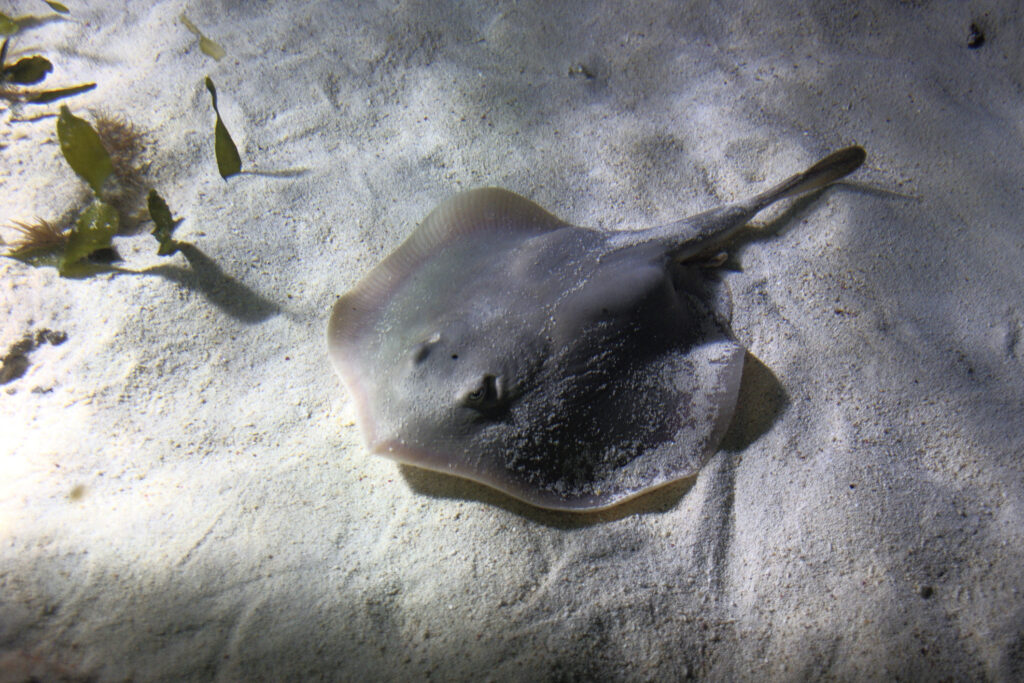The flapper skate (Dipturus intermedius) is one of Scotland’s most extraordinary and endangered marine species. Once thought to be the same as the “common skate,” it’s now recognised as a separate species — and one of the largest fish found in British waters.
What is a flapper skate?
The flapper skate belongs to the elasmobranch family, which also includes sharks and rays. Like them, it has a cartilaginous skeleton rather than bones, making it flexible and well adapted to life on the seafloor.
Until 2010, the flapper skate and the blue skate were grouped together as the “common skate.” Scientific studies have since shown that they are two distinct species, each with different appearances, genetics, and distributions.
Flapper skate appearance
Flapper skates have flat, diamond-shaped bodies covered in grey-brown skin with white spots across their backs. They have pointed snouts, wide wings, and long, spiny tails.
When they hatch, young flapper skates measure about 28 centimetres long, but adults can reach up to 2.5 metres — roughly the width of a king-size bed. Females tend to grow larger than males.
Males can be identified by two claspers, which are reproductive organs found near the pelvic fins. These may look like small extensions near the tail.
Flapper skate habitat and distribution
Flapper skates are found mainly in northern parts of the North Sea and around Scotland’s coasts. They prefer deep, sandy or muddy seabeds, where they rest and hunt, though they are strong swimmers capable of moving through fast-flowing tidal areas.
They’re often recorded around:
- The Orkney and Shetland Islands
- Scapa Flow
- The west coast of Scotland
- Marine Protected Areas such as Loch Sunart to the Sound of Jura
What do flapper skates eat?
Flapper skates are predators and scavengers. Their diet includes:
- Small fish such as flatfish and cod
- Crustaceans like crabs and shrimp
- Molluscs such as squid and shellfish
By feeding on species that live on or near the seabed, flapper skates help keep marine ecosystems balanced and healthy.

Why are flapper skates critically endangered?
The International Union for Conservation of Nature (IUCN) lists the flapper skate as Critically Endangered. The species has disappeared from much of its historical range due to several pressures.
Overfishing
Flapper skates were once targeted by both commercial and sport fisheries, and their large size means they are easily caught accidentally (as bycatch) in trawling gear.
Since 2009, it has been illegal to land or keep flapper skates in Scotland. Any caught must be carefully released under catch-and-release rules.
Habitat loss
Flapper skates lay their eggs on the seabed, often among cobbles or sand in shallow, sheltered areas. These sites are easily disturbed by bottom-towed fishing gear and other human activities, which can destroy the habitats where eggs develop.
Slow growth and low reproduction
Flapper skates mature slowly, often taking more than 10 years to reach adulthood. They produce relatively few eggs, which means their populations recover very slowly once depleted.
Flapper skate eggs
Flapper skate eggs — known as “mermaid purses” — are among the largest of any skate species. Each case can be 20–25 centimetres long, roughly the size of a rabbit.
The eggs are laid on the seabed and can take over a year, sometimes up to 18 months, to hatch. Because of this long development time, they are at high risk from fishing activity and habitat damage.
How Deep Sea World are supporting flapper skate conservation
Conservation groups and research projects across Scotland are working hard to protect remaining flapper skate populations.
At Deep Sea World, we’re proud to support this work alongside the Orkney Skate Trust, contributing to conservation research and public awareness campaigns. Educational displays, and ongoing partnerships help us highlight why this species matters — not just for Scottish waters, but for the health of our entire marine environment.
How you can help
- Learn and share: Tell others about flapper skates and why they’re important.
- Support conservation groups: Organisations like the Orkney Skate Trust and Shark Trust rely on donations and volunteers.
- Choose sustainable seafood: Look for products certified by the Marine Stewardship Council (MSC) to help reduce bycatch.
- Report sightings: Divers and anglers can record skate sightings or egg cases to help researchers track populations.
A Future for the flapper skate
Once common across the North Atlantic, flapper skates are now mostly found in Scottish waters. With continued protection, research, and education, we can give these gentle giants the best chance to recover — ensuring they remain a vital part of Scotland’s marine wildlife for generations to come.
On your next visit, you can support our collaboration with the Orkney Skate Trust by adding a donation to the cost of your admission. Book your tickets in advance today!
